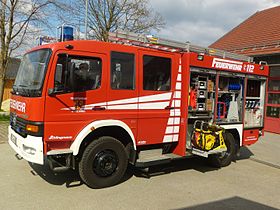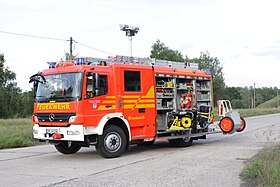Emergency fire fighting group vehicle
Emergency fire fighting vehicle ( HLF for short ) is the name of a type of German fire fighting vehicle of various sizes. This type of vehicle is outwardly almost identical to the fire fighting group vehicle and, like this, is designed for a group as a crew. The essential difference to the fire fighting vehicle is the extensive equipment for technical assistance .
In Berlin, corresponding vehicles are sometimes also referred to as fire-fighting vehicles or fire-fighting vehicles ( LHF for short ). As a combination of HLF and tank fire engine, the non-DIN-standardized emergency tank fire engine was sometimes used in Hessen . In Hamburg the designation HLF is used for the so-called " Hamburg fire trucks ". These are very similar to the norm of classic HLF.
Areas of responsibility
Emergency fire fighting group vehicles are the most diverse vehicles in the German fire service. They developed from the fire fighting vehicles when the fire brigades realized that their range of operations was increasingly shifting from fire fighting to technical assistance and therefore equipped their fire fighting vehicles with additional loads for accident assistance. Even before their standardization, the HLF were the most diverse devices of the fire brigade, which were used for all conceivable situations such as traffic accidents, dangerous goods operations and of course conventional fire operations.
history
The emergency fire fighting group vehicle is a comparatively young type of vehicle of the German fire brigades, for which DIN standards have only existed since the beginning of the 21st century . Previously, many fire brigades used their own constructions that went beyond the current standards for tank fire engines , portable fire pumps and fire fighting vehicles or had to carry rescue vehicles with them for smaller operations . Often such in-house designs were then called emergency fire-fighting vehicles (HLF). The first standard was the one for an HLF 20/16 (today HLF 20) from November 2004, intended to represent a compromise between the old standard of the LF 16/12 and the non-standardized special designs. Accordingly, the HLF 10/6 (today HLF 10) was created in 2007, which is based on the former standard for the LF 8/6 with additional load for technical assistance. In the abbreviations, the first number stands for the nominal delivery rate of the fire extinguishing pump in liters per minute at 10 bar delivery pressure; The number after the slash in the previous name indicated the (minimum) volume of the water tank in 100 liters according to the standard. In practice, there were subsequently also vehicles with a larger water tank (e.g. HLF 20/20 with a 2000 liter water tank), which are nevertheless subsumed under the respective types listed below. With the new type codes, this has become obsolete.
Types
Emergency fire fighting vehicle 10
|
Emergency fire fighting vehicle 10 |
|
|---|---|
| Vehicle data
|
|
| Abbreviation: | HLF 10 |
| Country: | Germany |
| Crew : | 0/1/8/ 9 |
| Fire pump : | FPN 10-1000 |
| Extinguishing water : | 1000 liters |
| Foam concentrate : | 6 × 20 liters |
| Extinguishing powder : | 6 kilograms |
| Rescue kit : | available |
| Perm. Total mass : | 12000 kilograms |
| Drive: | Road / four-wheel drive |
The emergency fire extinguishing group vehicle 10 (short: HLF 10 ) is the smaller version of this type of vehicle, was formerly (since 2007) HLF 10/6 and was standardized in DIN 14530 Part 5 together with the then LF 10/6 until 2012. It is now standardized in DIN 14530 Part 26. Its equipment in accordance with the new standard includes a water tank with a capacity of 1000 liters and a supply of 120 liters of foam concentrate. In the rear of the vehicle there is a centrifugal fire pump with a capacity of 1,000 liters of water per minute at an output pressure of 10 bar. It is closely related to the fire fighting group vehicle 10 , but does not necessarily have a pressure aerator and chimney toolbox, for example . However, according to the current standard, there are certainly a four-part extension ladder (or alternatively two multifunctional ladders ), four compressed air breathing apparatus , a respiratory protection monitoring system , two escape hoods , a power generator , lighting equipment, traffic accident box, coarse cleaning module, a submersible pump TP 4/1, reciprocating saw and a chainsaw on the HLF 10 loaded. In addition, however, there is additional, extensive equipment for technical assistance, which includes a hydraulic rescue set with rescue spreader (at least in the "BS" version), rescue scissors (at least in the "BC" version) and accessories. In Bavaria, the LF / HLF 10 in the all-wheel drive version may have a permissible total weight of 13 tons.
- Rescue group vehicle 10/10
In Rhineland-Palatinate, the fire brigade accident insurance funds issued a stipulation that a fire brigade may only carry out an internal attack without a stable water supply if it has at least 1,000 liters of water available at the scene. On the basis of this requirement, the technical directive No. 10 created the emergency fire extinguishing group vehicle 10/10 ( HLF 10/10 for short ), which corresponds to the HLF 10, but has a minimum tank size of 1,000 liters. With the new DIN standard for the HLF 10, this requirement is no longer necessary for emergency fire fighting vehicles.
Emergency fire fighting group vehicle 20
|
Emergency fire fighting group vehicle 20 |
|
|---|---|
| Vehicle data
|
|
| Abbreviation: | HLF 20 |
| Country: | Germany |
| Crew : | 0/1/8/ 9 |
| Fire pump : | FPN 10-2000 |
| Extinguishing water : | 1600 liters |
| Foam concentrate : | 6 × 20 liters |
| Extinguishing powder : | 2 × 6 kilograms |
| Rescue kit : | available |
| Perm. Total mass : | 15,000 kilograms |
| Drive: | Road / four-wheel drive |
The emergency fire extinguishing group vehicle 20 (short: HLF 20 ) is the larger version of this type of vehicle and accordingly goes beyond the loading of the HLF 10. Since 2004 it has been standardized as HLF 20/16 together with the then LF 20/16 in DIN 14530 Part 11. The current - slightly changed - standard is DIN 14530 Part 27. It has a 1,600 liter extinguishing water tank, 120 liters of foam concentrate and 12 kg of extinguishing powder. Its centrifugal fire pump can pump 2,000 liters of water per minute at an output pressure of 10 bar. Compared to the fire fighting group vehicle 20 , it often has a smaller water tank, but a more extensive load for technical assistance . According to the current status, the latter includes, among other things, a hydraulic rescue set (with a rescue spreader at least in the "BS" version, rescue scissors at least in the "BC" version and a set of rescue cylinders ), accessories, a traffic accident box and, in principle, a pneumatic lifting set . It includes an almost identical equipment for firefighters as the Löschgruppenfahrzeug 20: In addition to those water-bearing fittings, two escape hoods, a four-part scaling ladder (or alternatively two multifunction ladders), a three-part extension ladder and a jump parachute . Four compressed air breathing apparatus, a respiratory protection monitoring system, two manhole covers, four light chemical protective suits , power and lighting equipment, submersible pump TP 4/1, chainsaw and reciprocating saw must also be loaded. In the HLF 20, in contrast to the fire fighting group vehicles LF 10 and LF 20, neither a pressure fan nor a chimney toolbox have to be carried. In addition, the HLF 20 can be equipped with a mechanical pulling device , an additional load to combat water damage , fall protection or for the use of hazardous materials , and rarely with a portable pump . The vehicle can have four-wheel drive and has a permissible total weight of 15 tons. In Bavaria, HLF 20 can now have a permissible total weight of up to 16 tons.
Emergency fire-fighting vehicle 24/14 rail
The HLF 24/14-S is a non-standardized fire fighting group vehicle / special vehicle which is mainly used by professional fire brigades and is particularly equipped for rail accidents. For this purpose it can also run on rails. It usually has a water tank of more than 1,400 liters and, in addition to normal fire fighting, is also suitable for fire fighting in tunnels and technical accident assistance on the rail.
See also
literature
- Hamilton: Handbook for the Firefighter. Boorberg-Verlag, ISBN 3-415-01705-2 .
- Cimolino, Zawadke: Emergency vehicles for fire and rescue services (types). Ecomed Security, ISBN 3-609-68667-7 .
Individual evidence
- ↑ Standard overview page for an HLF 10 on din.de
- ↑ a b Bavarian State Ministry of the Interior, for Building and Transport (2015): Fire Brigade Funding Guidelines; Deviations from standard specifications for fire fighting vehicles - further addition .
- ↑ Standard overview page for an HLF 20 on din.de

